Africa and the Origins of Modern Humans

Jebel Irhoud
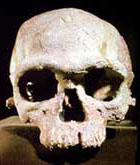
Jebel Irhoud is a cave site located about 100 km west of Marrakech, Morocco. The site is known for the numerous hominin fossils discovered there. Currently, the site has yielded seven specimens. The best known of these are portions of two adult skulls, Irhoud 1 and 2, a child’s mandible (Irhoud 3), and a child’s humerus (Irhoud 4). Fossils 1-3 were discovered while the cave was being quarried for barytes and thus their exact context and age has been subject to debate. Originally the Irhoud hominins were considered North African Neandertals. It is now clear that they are best grouped with other early anatomically modern humans such as Qafzeh (Israel) and Skhul (Israel).
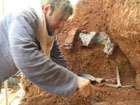
The industry associated with the deposits is clearly Middle Stone Age with Levallois technology and the fauna looks to be late Middle or early Upper Pleistocene. An initial attempt at radiocarbon dating showed the site to be beyond the limit of this technique. In 1991, Grun and Stringer reported ESR dates on three mammal teeth from a layer overlying the Irhoud 4 fossil. The results have a very large range and depending on which uranium uptake model is used could span from 90 to 190 thousand years ago.
The exact date of these fossils has become more important in the context of the “Out of Africa” model of modern human origins. It is currently suggested that modern humans had their origin in Africa sometime in the last 200,000 years. If the ESR dates are correct and particularly if one accepts the earliest dates, then the Jebel Irhoud hominins are amongst the oldest anatomically modern humans in Africa.
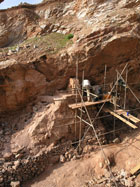
In May of 2004, the department along with the Institut National des Sciences de l’Archéologie et du Patrimoine (INSAP, Rabat, Morocco) started a new project at Jebel Irhoud. This work began with a short season to identify the remaining in situ deposits and to assess the feasibility of conducting new excavations. It was determined that only a limited column of in situ deposits with archaeological materials remained.
Since 2004 we have conducted several one month long field seasons in an effort to re-excavate and date the complete sequence. This work has produced a new map of the site, identified likely sources of raw material for the Middle Stone Age industries there, obtained new samples of these stone tool industries from the entire sequence, obtained new dating samples of heated flint, identified several in situ fire features, and identified the brecciated lower levels from which the previously recovered fossil hominins likely derive.
Additionally, in the 2007 season and in subsequent seasons, new hominin material was discovered near the base of the sequence. We are currently processing and analyzing the material collected during the last field seasons. Several publications are under preparation. The next field season is currently planned for late 2013 or early 2014.
A new study of the Irhoud 3 mandible was published in 2007 by Tanya Smith, Jean-Jacques Hublin and colleagues. This work shows that this individual was approximately 8 years old at death and showed a stage of development similar to modern European children of the same age. The implications are that this early Homo sapiens showed a modern human pattern of growth and development and likely experience a similarly prolonged childhood.
Smith, T.M., Tafforeau, P.T., Reid, D.J., Grün, R., Eggins, S., Boutakiout, M. & Hublin, J.-J. (2007) Earliest evidence of modern human life history in North African early Homo sapiens. Proc. Natl. Acad. Sci. USA 104:6128-6133. [pdf]
Rhafas Cave

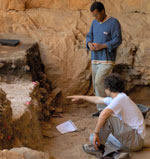
Rhafas is a small cave located at 900m elevation in the Oujda Mountains of northeast Morocco approximately 50km from the coast. The site, which was first excavated in the 1980s by L. Wengler, contains over 4.5m of deposits. Wengler has described, at the base of the sequence, a deep series of Middle Paleolithic or Middle Stone Age levels. Overlying this are a couple levels of Aterian, and at the top of the sequence is thin Neolithic deposit. In 2007, N. Mercier and colleagues published TL and OSL dates from a portion of the sequence. Their data suggest that the Middle Stone Age levels mostly date prior to 100 ka, that the latest Middle Stone Age dates to between 90-80 ka, and that the transition to the Aterian occurred between 80-70 ka.
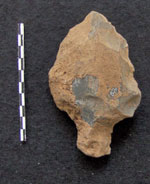
In 2007, the Max Planck Institute began working with Abdeljalil Bouzouggar of the Institut National des Sciences de l’Archéologie et du Patrimoine (INSAP, Rabat, Morocco) at the site of Rhafas. The goals of this project are focused primarily on the late Middle Stone Age and the transition to the Aterian. We are continuing the dating program begun by Mercier, and we are collecting new samples from the upper levels to better describe the lithic assemblages, to better understand the transition to Aterian, to do a zooarchaeological study of the associated fauna, to better understand the paleoenvironmental context, and to better understand the site formation processes.
Four seasons were completed. Currently the team is preparing papers based on the results. New OSL results are expected soon. Some of the shells were discussed in the following publication:
"Additional evidence on the use of personal ornaments in the Middle Paleolithic of North Africa" (2009) Proceedings of the National Academy of Sciences 106(38):16051-16056. (Francesco d’Errico, Marian Vanhaeren, Nick Barton, Abdeljalil Bouzouggar, Henk Mienis, Daniel Richter, Jean-Jacques Hublin, Shannon P. McPherron, Pierre Lozouet) [pdf]
Doerschner, N., Fitzsimmons, K. E., Ditchfield, P., McLaren, S. J., Steele, T. E., Zielhofer, C., McPherron, S. P., Bouzouggar, A. and Hublin, J.-J. (2016). A New Chronology for Rhafas, Northeast Morocco, Spanning the North African Middle Stone Age through to the Neolithic. PLoS ONE, 11(9), e0162280. doi: 10.1371/journal.pone.0162280.
Montagu
History of excavation and site importance
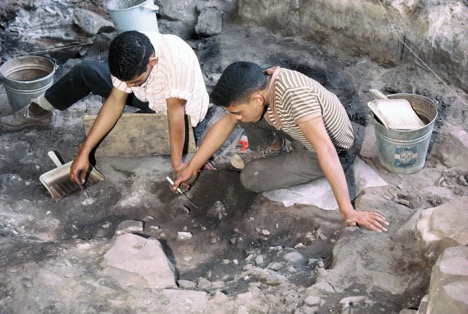
Montagu Cave has been excavated on two previous occasions, in 1919 by Houghten and Barnard from the Cape Town Museum, and in 1963/64 by Charles M. Keller, as a component of his dissertation research at the University of California, Berkeley. The excavation in 1919 took place over a period of a few months wherein >75% of the archaeological deposits were removed from the shelter with picks and shovels. Huge numbers of artefacts were recovered, however the methods of recovery and the limited documentation of the 1919 excavation suggest that these older collections are not possible to correlate with the current work at the site, and have limited research value. In 1964 Keller – under the guidance of his advisor, Prof. J. Desmond Clark – was interested in digging an Acheulean site in primary, or close to primary stratigraphic context. Inspired by his experiences excavating at the Acheulean site of Kalambo Falls, Keller’s focus was on investigating Acheulean behavioural variability through documenting ‘living surfaces’ represented by lateral spatial distributions of stone artefacts. He initiated re-excavation of Montagu Cave with this purpose in mind. As a result of these spatial objectives Keller dug Montagu Cave slowly and meticulously, and piece-plotted huge numbers of artefacts lying on what were believed to be intact discrete living surfaces occurring through the Acheulean and Middle Stone Age sequences.
Hominin behavior underwent dramatic changes shortly after the onset of the African Middle Stone Age. However, the mechanisms associated with the transition from the preceding Acheulean remain poorly understood, largely due to the paucity of localities documenting a stratigraphic succession between the Acheulean and Middle Stone Age. Montagu Cave is one of a small handful of African sites which have Early, Middle and Later Stone Age archaeological deposits within the same stratigraphic sequence.
Current excavations and objectives
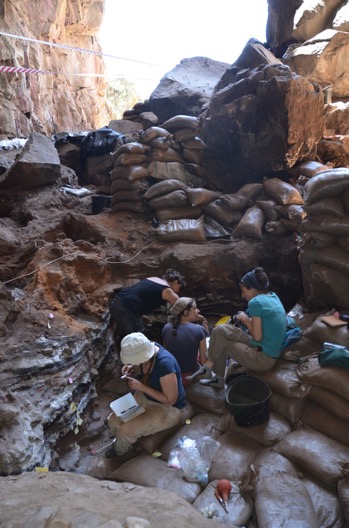
In 2015, in close collaboration with the Department of Archaeology at the University of Cape Town, we started a project with the key objective of contextualizing and salvaging the remaining deposits at Montagu Cave. The field-work is co-directed by Dr. Will Archer, Dr. Alexandra Sumners (DePaul University), and Louisa Hutten (University of Cape Town). Our current objectives include excavation of both the Middle Stone Age occupations and the underlying deeply stratified Acheulian deposits using modern excavation and recording methodologies. Our interdisciplinary approach includes studies on site formation processes, geoarchaeology, dating, lithic analysis, lithic raw-material sourcing, and phytolith identification. A series of papers reporting on this new research program are planned for late 2018-2019. The renewed fieldwork program at Montagu provides scope for investigating detailed questions concerning hominin behavioural variability, in a time window just prior to the period characterized by rapidly increasing complexity in the Southern African archaeological record. In addition, we are able to explore how this increasing complexity manifests itself in direct comparison with in situ instances of chronologically preceding material cultures, conventionally assumed to be pre-modern.